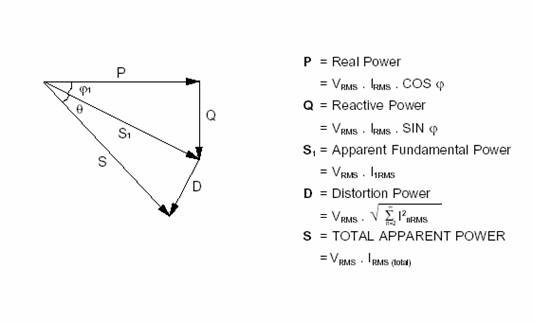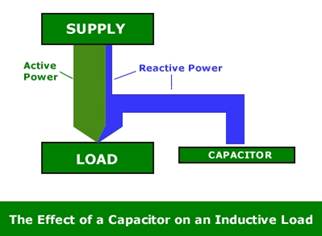| EnviroVAr Power Factor Control System
The EnviroVAr power factor correction provides effective reactive
power compensation for all industrial, commercial and large retail
environments where excess charges are being applied and or where
current availability is limited and the cost of a replacement transformer
or increased supply is prohibitive.
The Problem
Most three phase electrical loads draw not only active power
(kW, the part that does useful work), from the supply, but also
reactive power (kVAr, essential, but ‘Wattless’ power); examples
of these loads would be induction motors, motor drives (both AC
and DC ) , switch-mode power supplies, and most forms of lighting.
|
|
|
To make a very crude example of an induction motor,
the active power is what comes out of the shaft and does work,
whilst the reactive power is what is used by the coils of the stator
to create the magnetic field. This magnetic field is essential
for the operation of the motor, but does no actual work, only permitting
the transfer of power from the stator to the rotor.
The total demand on the supply for a load of this type is called
the apparent power, and is the vector sum of both the active and
reactive components of power. The ‘power factor’ of a load is the
ratio of active power to apparent power, kW to kVA, sometimes referred
to as Cos ( f ). When a load draws reactive power from the supply,
its power factor is said to be lagging, when the reactive power
is exported to the supply, its power factor is said to be leading.
This is a reference to the phase of the load current with respect
to the supply voltage.
This is the ‘Displacement Power Factor’ or DPF, more commonly
known as just the ‘Power Factor’ and only takes into consideration
the frequency components of voltage and current.
|
|

When seeking to improve the power factor of a load, what is actually
being done is to supply a proportion of the reactive power demand
of this load locally. This results in a greater proportion of active
current being drawn from the supply.
|

With no power factor correction equipment installed, the supply
is required to provide the total active and reactive power demand
of the load.
|

With a capacitor installed electrically adjacent
to a load, the supply is required only to provide the active power
demand, and a smaller proportion of the reactive power demand.
|
Physical Benefits of Power Factor Correction
The reduction in demand on the supply from the installation of
Power Factor Correction equipment results in:
- ‘Spare’ supply capacity which may be used to connect additional
load without the necessity of network reinforcement
- Reduced losses and hence reduced heating in transformers,
cables and switchgear, increasing reliability, useful service
life, and reducing servicing costs
- Reduction in reactive power demand from the supply improves
voltage regulation, as to a first approximation, the voltage
drop in a supply network is proportional to the reactive power
supplied by that network ( D V @ QX, where D V is the voltage
drop, Q the reactive power demand, and X the system reactance)
- An increase in Power Quality, as the presence of a large capacitor
bank gives significant attenuation of mains borne voltage spikes,
and can also reduce the effects of short duration dips or notches
in the supply voltage
- Reduction in distribution system losses means that fewer kWh
are required from the electricity generators, resulting in lower
carbon dioxide emissions
Contractual benefits of Power Factor Correction
- Most contracts for the supply of electricity stipulate a minimum
power factor for the load to be connected, though this is often
ignored by both supplier and consumer until problems occur, at
which point the solution is more costly than would have been
the case had the situation been addressed initially
- Engineering Recommendation G5/4, (relates to planning levels
for harmonic voltage distortion and the connection of non-linear
equipment to transmission systems and distribution networks in
the United Kingdom), is now enforceable legislation. The use
of detuned capacitor banks has the effect of absorbing a proportion
of any harmonic currents produced by the load, and can often
result in compliance with G5/4 without the need for further harmonic
reduction equipment.
- Engineering Recommendation P28, (relates to planning limits
for voltage fluctuations caused by industrial, commercial and
domestic equipment in the United Kingdom), details limits on
‘Voltage Flicker’. As the majority of flicker is caused by voltage
drop due to sudden reactive power demand, the installation of
power factor correction capacitors can reduce the levels of flicker
to within acceptable limits without the need for supply reinforcement.
- Organizations having or seeking approval under ISO14001 (Environmental
Management) can easily show increased electrical efficiencies
and reduction in carbon emissions by implementing an appropriate
Power Factor Correction scheme.
Financial Benefits of Power Factor Correction
- Reduction in kVA required to supply a given kW load means
that initial capital expenditure can be reduced, as the primary
distribution network components (transformers, switchgear etc.)
can be reduced in rating and hence Cost.
- Reduction in losses in distribution equipment due to reduced
demand on the supply is reflected in the kWh usage for the site.
Whilst this reduction in kWh consumption may at first appear
to be small, it can amount to between 1% and 3% of the total
consumption, with the associated savings in electricity charges.
- The tariff under which charges are made for electricity may
include items which relate directly or indirectly to poor power
factor. These are usually specific to the consumer, and hence
generalizations are difficult. Items falling into this category
which may be affected include Authorized Supply Capacity, Metered
Monthly Maximum Demand, and Reactive Unit charges.
EnviroVAr systems are available as both "standard" systems and
also as "detuned" systems with additional inductive reactive filters
to limit harmonic currents within a circuit. For a full understanding
of these systems go to the links above and then contact your local
EMS (European) representative to arrange a site survey to best
advise you as to how you can benefit from effective power factor
correction
|
|
|


